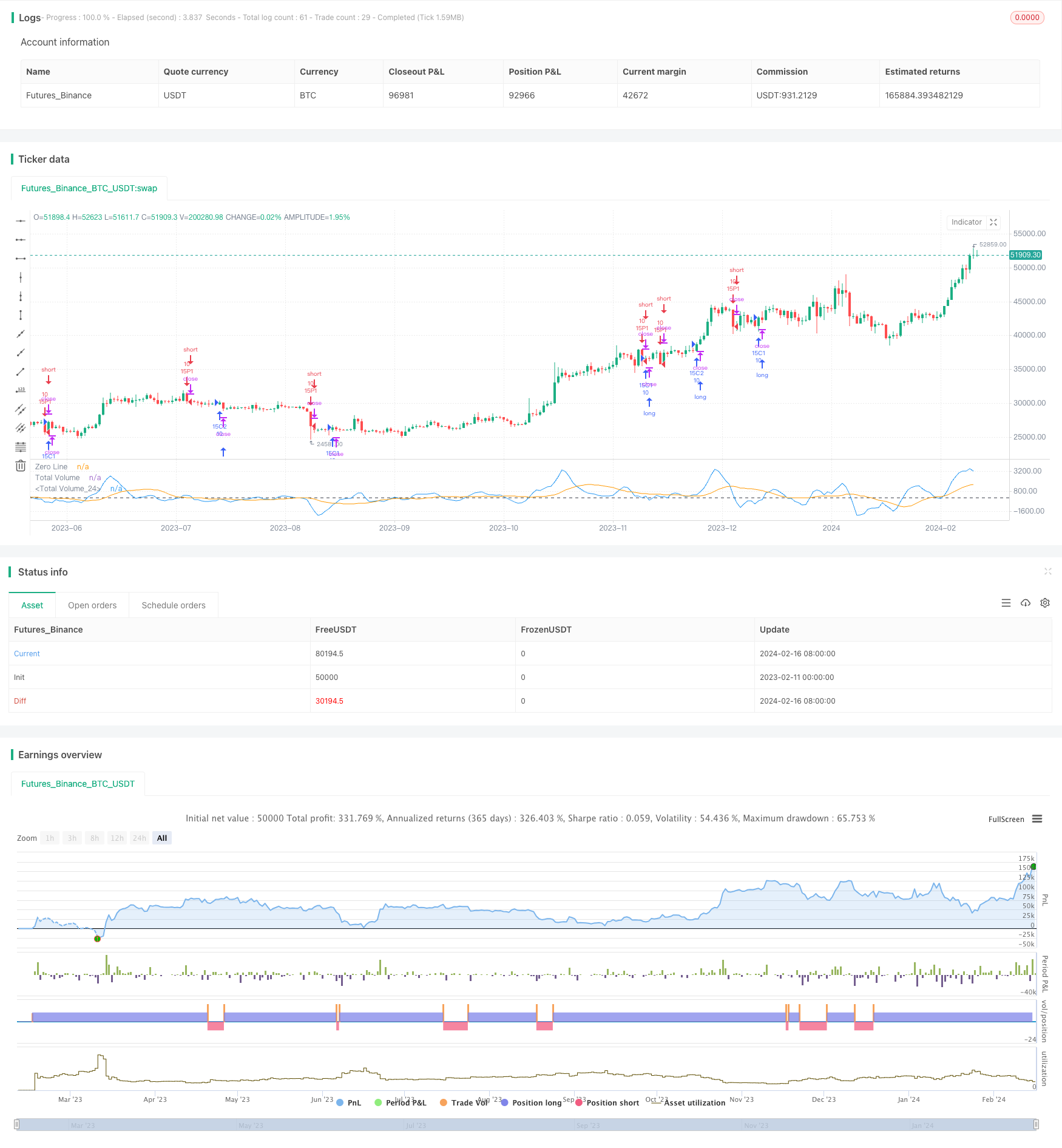
概述
多时间周期MACD零轴交叉反转策略通过计算不同周期的MACD指标,识别价格可能反转的信号,采用趋势跟踪止损方式,追求较高的资金利用效率。
策略原理
该策略同时计算3周期和10周期的SMA移动平均线,构建快慢线,再计算MACD指标和信号线。当快线和信号线发生向上或向下的零轴交叉时,说明价格达到临界点,有可能出现反转。此外,该策略还结合了成交量的多空态势判断、RSI指标等,来识别反转信号的可靠性。当反转信号达到一定可靠性要求时,做多或做空。
具体来说,策略通过以下方法判断价格反转:
1. MACD零轴交叉,说明价格达到临界点
2. 成交量的买卖压力判断多空态势
3. RSI指标看涨跌势力,结合MACD斜率变化,判断反转信号强度
4. 快线和信号线反向交叉,形成反转信号
当反转信号可靠性较高时,策略采用趋势跟踪止损方式入场,追求较高收益。
优势分析
该策略具有以下几个优势:
- 多指标判断,使反转信号更加可靠
- 采用MACD零轴交叉判断反转点位,精准度较高
- RSI指标和成交量辅助判断,可靠性高
- 趋势跟踪止损方式,追求较高资金利用效率
风险分析
该策略也存在一些风险:
- MACD指标发出假信号的概率较大,容易被套住
- 多空交替过程中,止损被击穿概率较大
- 参数设置不当可能导致过于频繁交易,增加交易成本和滑点损失
可以通过以下方式减少风险:
1. 适当放宽止损幅度,避免被套
2. 优化参数,降低交易频率
3. 只在关键支撑阻力位附近考虑入场
优化方向
该策略还可进一步优化的方向包括:
- 增加机器学习算法,辅助判断反转信号可靠性
- 增加情绪指标判断多空心理面
- 结合关键支撑阻力位,提高入场精确度
- 优化止损方式,进一步提高资金利用效率
- 测试最优参数组合,降低交易频率
总结
多时间周期MACD零轴交叉反转策略,综合考量了价格、成交量和波动指标等多个维度的信息,通过多指标判断确定反转入场时机,在盈利充分后及时止损,能够在反转行情中获得较好收益。该策略有望通过机器学习和关键位优化等方式进一步改进,以减少交易频率和风险,提高盈利空间。
策略源码
/*backtest
start: 2023-02-11 00:00:00
end: 2024-02-17 00:00:00
period: 1d
basePeriod: 1h
exchanges: [{"eid":"Futures_Binance","currency":"BTC_USDT"}]
*/
//@version=5
strategy("3 10.0 Oscillator Profile Flagging", shorttitle="3 10.0 Oscillator Profile Flagging", overlay=false)
signalBiasValue = input(title="Signal Bias", defval=0.26)
macdBiasValue = input(title="MACD Bias", defval=0.8)
shortLookBack = input( title="Short LookBack", defval=3)
longLookBack = input( title="Long LookBack", defval=10.0)
takeProfit = input( title="Take Profit", defval=0.8)
stopLoss = input( title="Stop Loss", defval=0.75)
fast_ma = ta.sma(close, 3)
slow_ma = ta.sma(close, 10)
macd = fast_ma - slow_ma
signal = ta.sma(macd, 16)
hline(0, "Zero Line", color = color.black)
buyVolume = volume*((close-low)/(high-low))
sellVolume = volume*((high-close)/(high-low))
buyVolSlope = buyVolume - buyVolume[1]
sellVolSlope = sellVolume - sellVolume[1]
signalSlope = ( signal - signal[1] )
macdSlope = ( macd - macd[1] )
plot(macd, color=color.blue, title="Total Volume")
plot(signal, color=color.orange, title="Total Volume")
intrabarRange = high - low
rsi = ta.rsi(close, 14)
rsiSlope = rsi - rsi[1]
getRSISlopeChange(lookBack) =>
j = 0
for i = 0 to lookBack
if ( rsi[i] - rsi[ i + 1 ] ) > -5
j += 1
j
getBuyerVolBias(lookBack) =>
j = 0
for i = 1 to lookBack
if buyVolume[i] > sellVolume[i]
j += 1
j
getSellerVolBias(lookBack) =>
j = 0
for i = 1 to lookBack
if sellVolume[i] > buyVolume[i]
j += 1
j
getVolBias(lookBack) =>
float b = 0.0
float s = 0.0
for i = 1 to lookBack
b += buyVolume[i]
s += sellVolume[i]
b > s
getSignalBuyerBias(lookBack) =>
j = 0
for i = 1 to lookBack
if signal[i] > signalBiasValue
j += 1
j
getSignalSellerBias(lookBack) =>
j = 0
for i = 1 to lookBack
if signal[i] < ( 0.0 - signalBiasValue )
j += 1
j
getSignalNoBias(lookBack) =>
j = 0
for i = 1 to lookBack
if signal[i] < signalBiasValue and signal[i] > ( 0.0 - signalBiasValue )
j += 1
j
getPriceRising(lookBack) =>
j = 0
for i = 1 to lookBack
if close[i] > close[i + 1]
j += 1
j
getPriceFalling(lookBack) =>
j = 0
for i = 1 to lookBack
if close[i] < close[i + 1]
j += 1
j
getRangeNarrowing(lookBack) =>
j = 0
for i = 1 to lookBack
if intrabarRange[i] < intrabarRange[i + 1]
j+= 1
j
getRangeBroadening(lookBack) =>
j = 0
for i = 1 to lookBack
if intrabarRange[i] > intrabarRange[i + 1]
j+= 1
j
bool isNegativeSignalReversal = signalSlope < 0.0 and signalSlope[1] > 0.0
bool isNegativeMacdReversal = macdSlope < 0.0 and macdSlope[1] > 0.0
bool isPositiveSignalReversal = signalSlope > 0.0 and signalSlope[1] < 0.0
bool isPositiveMacdReversal = macdSlope > 0.0 and macdSlope[1] < 0.0
bool hasBearInversion = signalSlope > 0.0 and macdSlope < 0.0
bool hasBullInversion = signalSlope < 0.0 and macdSlope > 0.0
bool hasSignalBias = math.abs(signal) >= signalBiasValue
bool hasNoSignalBias = signal < signalBiasValue and signal > ( 0.0 - signalBiasValue )
bool hasSignalBuyerBias = hasSignalBias and signal > 0.0
bool hasSignalSellerBias = hasSignalBias and signal < 0.0
bool hasPositiveMACDBias = macd > macdBiasValue
bool hasNegativeMACDBias = macd < ( 0.0 - macdBiasValue )
bool hasBullAntiPattern = ta.crossunder(macd, signal)
bool hasBearAntiPattern = ta.crossover(macd, signal)
bool hasSignificantBuyerVolBias = buyVolume > ( sellVolume * 1.5 )
bool hasSignificantSellerVolBias = sellVolume > ( buyVolume * 1.5 )
// 393.60 Profit 52.26% 15m
if ( hasBullInversion and rsiSlope > 1.5 and volume > 300000.0 )
strategy.entry("15C1", strategy.long, qty=10.0)
strategy.exit("TPS", "15C1", limit=strategy.position_avg_price + takeProfit, stop=strategy.position_avg_price - stopLoss)
// 356.10 Profit 51,45% 15m
if ( getVolBias(shortLookBack) == false and rsiSlope > 3.0 and signalSlope > 0)
strategy.entry("15C2", strategy.long, qty=10.0)
strategy.exit("TPS", "15C2", limit=strategy.position_avg_price + takeProfit, stop=strategy.position_avg_price - stopLoss)
// 124 Profit 52% 15m
if ( rsiSlope < -11.25 and macdSlope < 0.0 and signalSlope < 0.0)
strategy.entry("15P1", strategy.short, qty=10.0)
strategy.exit("TPS", "15P1", limit=strategy.position_avg_price - takeProfit, stop=strategy.position_avg_price + stopLoss)
// 455.40 Profit 49% 15m
if ( math.abs(math.abs(macd) - math.abs(signal)) < .1 and buyVolume > sellVolume and hasBullInversion)
strategy.entry("15P2", strategy.short, qty=10.0)
strategy.exit("TPS", "15P2", limit=strategy.position_avg_price - takeProfit, stop=strategy.position_avg_price + stopLoss)